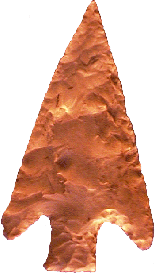

Point Type: BUCK
CREEK BARBED
Also See: Apple Creek, Crooked Creek,
Cypress Stemmed, Glacial Kame Stemmed, Hamilton, Kampsville
Barbed, Lone Tree, Mo-Pac, Motley, Smithsonia,
Springly, Table Rock, Wade
Location: Southern Indiana & Kentucky and Surrounding States
Associated Dates:
3500 - 2500 B.P. - Late Archaic - Early Woodland
Morphology: Stemmed
General Description: The Buck Creek Barbed is medium to large sized, thin, broad, stemmed point with strong barbed shoulders and typically crafted with high quality flaking. Some examples have needle tips. The blade is triangular in overall shape with some examples being very elongated. The blade edges are usually straight but can be recurved or convex. The barbs and upper portion of the stem are produced by a corner notching technique. The lateral edges of the lower stem and the stem base are carefully chipped on both faces to produce a beveled edge. The stem is long and narrow in relation to the total length of the point and can be straight to slightly expanding. The basal edge is usually straight but can be slightly convex. A particular trait of the point is the fact that the stem is usually thinned from the base, one-third to one-half of the way up the length of the stem.
The Buck Creek points are usually found in Southern Indiana along the Ohio River and Kentucky. They are common in southeastern Indiana and extend into southern Ohio, southeastern Illinois, northwestern Kentucky, northeastern Arkansas, southeastern Missouri and western Tennessee. The Buck Creek Barbed may be related to the Kampsville Barbed type which is found in west-central Illinois and the northern Alabama Wade type.
The size of the Buck Creek Barbed point ranges from 42 to 93 mm in length. The average size for the point is in the 60 mm range. The width ranges from 25 to 51 mm with the average being 33 mm. The maximum thickness range is between 5 and 9 mm with the average being 7 mm. The blade length is between 27 and 87 mm with the average being 42 mm. The stem length is between 12 and 19 mm with the average being 17 mm. Stem width is between 14 and 21 mm with the average being 17 mm. The point was named by Mark Seeman in 1975 for points he found at the Buck Creek in Harrison County, Indiana.
About the Point Above: The large Buck Creek Barbed blade pictured at the top of this page was found near the town of Clifton, Wayne Co., Tennessee. It is made from a dull gray and tan chert material. Overall the point measures 89 mm in length, 48 mm wide at the barbs and 9 mm at its thickest point, which is just above the stem at mid blade. The stem is not ground but is thinned to only 4 mm in thickness from the base to 13 mm up from the base. The stem measures 17 mm wide at the basal end and is 19 mm long. The typical blade thickness is only 5 mm. The blade length is 83 mm on each edge. The barbs are thinned to only 3 mm. The blade is highly patinated and a few high knapping scars show the effects of polish or rounding probably due to natural causes after loss. Catalog Number 26-195-G
References: Justice, Overstreet, Perino (1)
© Copyright 1997 - 2008 LITHICS-Net WWW.LITHICSNET.COM
Use Your Browser's BACK Button to Return to the LITHICS-Net Index.